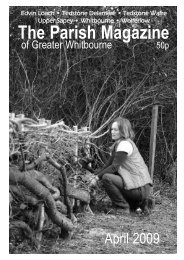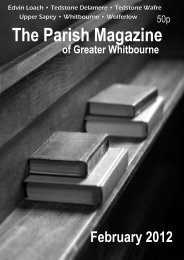click - Parish of Greater Whitbourne
click - Parish of Greater Whitbourne
click - Parish of Greater Whitbourne
Create successful ePaper yourself
Turn your PDF publications into a flip-book with our unique Google optimized e-Paper software.
From the RectorNovember 1st All Saints DayJesus wept. It used to be the standardanswer to the quiz question: “What isthe shortest verse in the Bible?” If thequestion refers to the King JamesBible, it still is!In many <strong>of</strong> the new translations,however, it has lost its status to Job3:2 (look it up!) because “Jesus wept”has now become “Jesus began toweep.” It may lack the punch but it’s abetter translation <strong>of</strong> the Greek, whichrefers to something that has startedand is ongoing.You may know the popular expansion<strong>of</strong> the familiar version, dating from atleast the nineteenth century: “Jesuswept and well he might, to see thepoor in such a plight.” It’s as truetoday as it ever was. One thinks <strong>of</strong> theprotest camp erected a year agooutside St Paul’s Cathedral in London,beneath the banner, “What wouldJesus do?” What indeed, when facedwith a world <strong>of</strong> poverty and sufferingfor the many, while a privileged fewmake a fortune! Would he not weep?And what does any <strong>of</strong> it have to dowith the feast <strong>of</strong> All Saints? Preciselythat Jesus holds out hope <strong>of</strong> a betterfuture for all who believe. Whetherwe’re a practical Martha or anemotional Mary, whether we’re abanker or a baker, a cathedral canonor a passionate protester, whetherwe’re black or white, old or young,whether we’re cynical or eager tobelieve – that invitation from theweeping Jesus goes out to us all, notjust those who now have cathedralsdedicated to them.The onlookers’ reaction to Jesus’ tearsis: “See how he loved him!” That maywell have been true, but it was thesight <strong>of</strong> Mary and other mournersweeping that disturbed and deeplymoved him, even to tears. Jesus weptwhen he saw their suffering… andthen acted, to put an end to it, first byraising Lazarus, but later by dying forhim, for everyone, and rising from thedead himself – so that all mightbelieve.Most <strong>of</strong> the protestors outside StPaul’s (or “occupying” Wall Street orMadrid’s Plaza del Sol) would notdescribe themselves as saints. Manyare not even Christians. But they areguided, <strong>of</strong>ten without realising it, bythe moral compass <strong>of</strong> the exampleand teaching <strong>of</strong> Jesus.As believers, we trust in God’spromise <strong>of</strong> eternal life, trust that ourdeparted loved ones and all the earliersaints are at rest. But that is no excusefor condoning the suffering <strong>of</strong> thisworld. In the words <strong>of</strong> today’straditional collect, we are the mysticalbody <strong>of</strong> Christ – all <strong>of</strong> us, here onearth, now. If we are his body, we arehis hands, his feet, his heart… histears.Jesus knew Lazarus was at peace, buthe saw other friends grieving and it3 November 2012
















